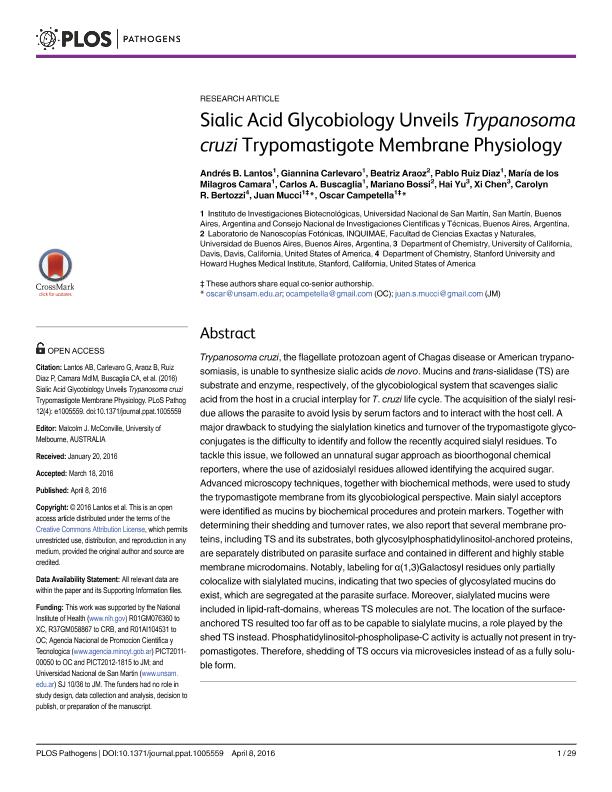Artículo
Sialic Acid Glycobiology Unveils Trypanosoma cruzi Trypomastigote Membrane Physiology
Lantos, Andrés Bernardo Gabriel ; Carlevaro, Giannina Alejandra
; Carlevaro, Giannina Alejandra ; Araoz, Beatriz
; Araoz, Beatriz ; Ruiz Díaz, Pablo Daniel
; Ruiz Díaz, Pablo Daniel ; Camara, María de los Milagros
; Camara, María de los Milagros ; Buscaglia, Carlos Andres
; Buscaglia, Carlos Andres ; Bossi, Mariano Luis
; Bossi, Mariano Luis ; Yu, Hai; Chen, Xi; Bertozzi, Carolyn R.; Mucci, Juan Sebastián
; Yu, Hai; Chen, Xi; Bertozzi, Carolyn R.; Mucci, Juan Sebastián ; Campetella, Oscar Eduardo
; Campetella, Oscar Eduardo
 ; Carlevaro, Giannina Alejandra
; Carlevaro, Giannina Alejandra ; Araoz, Beatriz
; Araoz, Beatriz ; Ruiz Díaz, Pablo Daniel
; Ruiz Díaz, Pablo Daniel ; Camara, María de los Milagros
; Camara, María de los Milagros ; Buscaglia, Carlos Andres
; Buscaglia, Carlos Andres ; Bossi, Mariano Luis
; Bossi, Mariano Luis ; Yu, Hai; Chen, Xi; Bertozzi, Carolyn R.; Mucci, Juan Sebastián
; Yu, Hai; Chen, Xi; Bertozzi, Carolyn R.; Mucci, Juan Sebastián ; Campetella, Oscar Eduardo
; Campetella, Oscar Eduardo
Fecha de publicación:
04/2016
Editorial:
Public Library of Science
Revista:
Plos Pathogens
e-ISSN:
1553-7366
Idioma:
Inglés
Tipo de recurso:
Artículo publicado
Clasificación temática:
Resumen
Trypanosoma cruzi, the flagellate protozoan agent of Chagas disease or American trypanosomiasis, is unable to synthesize sialic acids de novo. Mucins and trans-sialidase (TS) are substrate and enzyme, respectively, of the glycobiological system that scavenges sialic acid from the host in a crucial interplay for T. cruzi life cycle. The acquisition of the sialyl residue allows the parasite to avoid lysis by serum factors and to interact with the host cell. A major drawback to studying the sialylation kinetics and turnover of the trypomastigote glycoconjugates is the difficulty to identify and follow the recently acquired sialyl residues. To tackle this issue, we followed an unnatural sugar approach as bioorthogonal chemical reporters, where the use of azidosialyl residues allowed identifying the acquired sugar. Advanced microscopy techniques, together with biochemical methods, were used to study the trypomastigote membrane from its glycobiological perspective. Main sialyl acceptors were identified as mucins by biochemical procedures and protein markers. Together with determining their shedding and turnover rates, we also report that several membrane proteins, including TS and its substrates, both glycosylphosphatidylinositol-anchored proteins, are separately distributed on parasite surface and contained in different and highly stable membrane microdomains. Notably, labeling for α(1,3)Galactosyl residues only partially colocalize with sialylated mucins, indicating that two species of glycosylated mucins do exist, which are segregated at the parasite surface. Moreover, sialylated mucins were included in lipid-raft-domains, whereas TS molecules are not. The location of the surface-anchored TS resulted too far off as to be capable to sialylate mucins, a role played by the shed TS instead. Phosphatidylinositol-phospholipase-C activity is actually not present in trypomastigotes. Therefore, shedding of TS occurs via microvesicles instead of as a fully soluble form.
Palabras clave:
Trypanosoma Cruzi
,
Trans-Sialidase
,
Mucin
,
Membrane Proteins
Archivos asociados
Licencia
Identificadores
Colecciones
Articulos(IIB-INTECH)
Articulos de INST.DE INVEST.BIOTECNOLOGICAS - INSTITUTO TECNOLOGICO CHASCOMUS
Articulos de INST.DE INVEST.BIOTECNOLOGICAS - INSTITUTO TECNOLOGICO CHASCOMUS
Articulos(INQUIMAE)
Articulos de INST.D/QUIM FIS D/L MATERIALES MEDIOAMB Y ENERGIA
Articulos de INST.D/QUIM FIS D/L MATERIALES MEDIOAMB Y ENERGIA
Citación
Lantos, Andrés Bernardo Gabriel; Carlevaro, Giannina Alejandra; Araoz, Beatriz; Ruiz Díaz, Pablo Daniel; Camara, María de los Milagros; et al.; Sialic Acid Glycobiology Unveils Trypanosoma cruzi Trypomastigote Membrane Physiology
; Public Library of Science; Plos Pathogens; 12; 4; 4-2016; 1-29; e1005559
Compartir
Altmétricas



